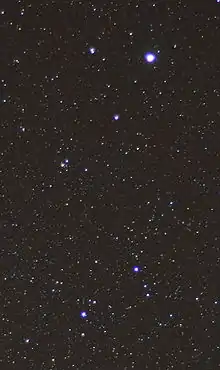Delta Lyrae cluster
Delta Lyrae cluster is a sparse open cluster of stars located about 1,220[2] light years away in the northern constellation of Lyra. Centered on the member star Delta2 Lyrae for which it is named.[3]
| Delta Lyrae cluster | |
|---|---|
 | |
| Observation data (J2000 epoch) | |
| Constellation | Lyra |
| Right ascension | 18h 53m 30.(0)s[1] |
| Declination | +36° 55′ 0(0)″[1] |
| Distance | 1,220 ly (373 pc)[2] |
| Apparent magnitude (V) | 3.8[3] |
| Apparent dimensions (V) | 20′[3] |
| Physical characteristics | |
| Mass | 589[4] M☉ |
| Estimated age | 49 Myr[5] |
| Other designations | Stephenson 1[6] |
This cluster was first suspected in 1959 by American astronomer Charles B. Stephenson, then was later concluded not to exist by German astronomer Werner Bronkalla in 1963. However, subsequent photometric observations at the Palomar and Mount Wilson observatories led American astronomer Olin J. Eggen to demonstrate that there was an actual cluster, at least for the observed stars down to absolute magnitude +5.5. Eggen's study found at least 33 members.[7]
The cluster has a visual magnitude of 3.8 and spans an angular diameter of 20 arc minutes.[3] The tidal radius of the cluster is 38 ly (11.5 pc) and it has an estimated combined mass of 589 times the mass of the Sun.[4] Based upon its estimated age and motion through space, it may be associated with the Gould Belt.[5] It includes an Algol variable star, BD+36° 3317, discovered in 2007 from Spain: this is a spectroscopic binary star system that undergoes regular eclipses because the orbital plane is nearly aligned with the line of sight to the Earth.[2]
See also
References
- Wu, Zhen-Yu; et al. (November 2009), "The orbits of open clusters in the Galaxy", Monthly Notices of the Royal Astronomical Society, 399 (4): 2146–2164, arXiv:0909.3737, Bibcode:2009MNRAS.399.2146W, doi:10.1111/j.1365-2966.2009.15416.x.
- Özdarcan, O.; et al. (July 2012), "BD+36 3317: An algol type eclipsing binary in Delta Lyrae cluster", New Astronomy, 17 (5): 483–487, arXiv:1207.0194, Bibcode:2012NewA...17..483O, doi:10.1016/j.newast.2011.12.002.
- Crossen, Craig; Rhemann, Gerald (2012), Sky Vistas: Astronomy for Binoculars and Richest-Field Telescopes, Springer Science & Business Media, ISBN 3709106265, retrieved 2015-11-10.
- Piskunov, A. E.; et al. (January 2008), "Tidal radii and masses of open clusters", Astronomy and Astrophysics, 477 (1): 165–172, Bibcode:2008A&A...477..165P, doi:10.1051/0004-6361:20078525.
- Piskunov, A. E.; et al. (January 2006), "Revisiting the population of Galactic open clusters", Astronomy and Astrophysics, 445 (2): 545–565, arXiv:astro-ph/0508575, Bibcode:2006A&A...445..545P, doi:10.1051/0004-6361:20053764.
- "NAME del Lyr Cluster". SIMBAD. Centre de données astronomiques de Strasbourg. Retrieved 2015-11-10.
- Eggen, O. J. (April 1968), "Photometric evidence for the existence of a delta Lyrae cluster", Astrophysical Journal, 152: 77, Bibcode:1968ApJ...152...77E, doi:10.1086/149525.